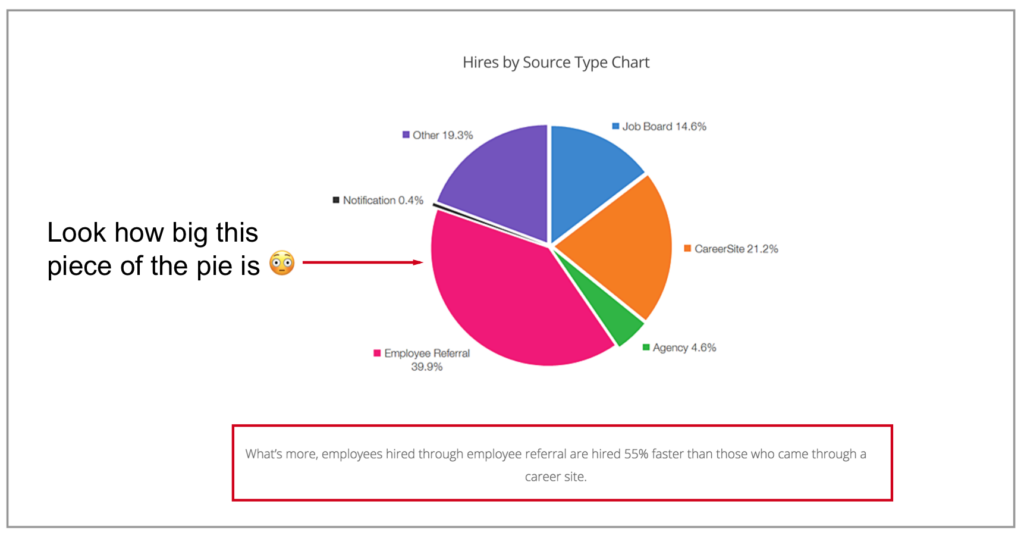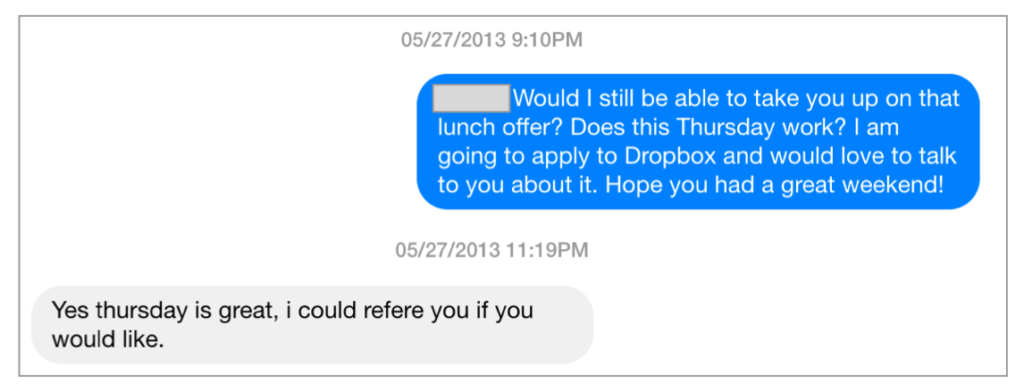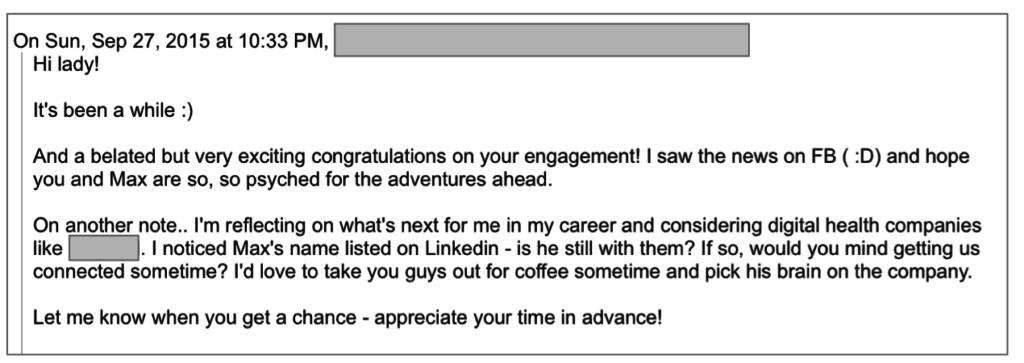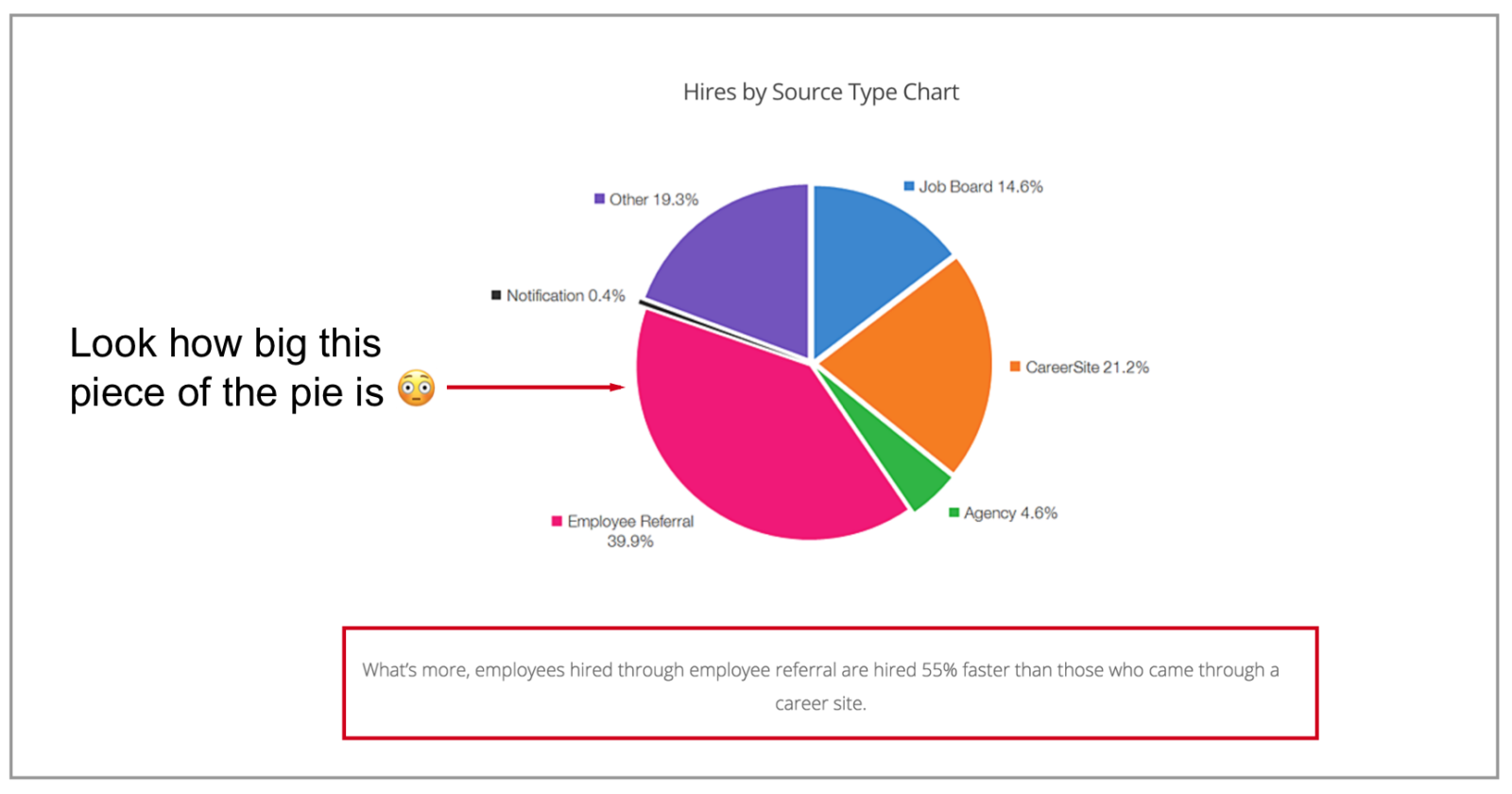Don’t just shoot your resume to jobs@company.com like a n00b
🤔 Is this you?
I applied to like 10 tech companies today. I’m really motivated to get a new job, I’ve been hammering out applications online all day.
You’re doing it wrong.
You should only apply blindly online as a last resort. You need to get a referral.
What’s a referral?
A referral is when a current employee, let’s call her Lisa, submits your job application on your behalf. Lisa is essentially recommending to the company that you would be a good fit.
Numbers don’t lie: referrals are the best way to apply
According to the Jobvite Index, which looked at data from their customers like LinkedIn, Spotify, and OpenTable:
40% (ok, 39.9%) of a company’s hires were through employee referrals.
Referrals are the number one source for hires, almost double the next largest source of hires (emphasis mine):

Also, read the text below that chart carefully, it says:
What’s more, employees hired through employee referral are hired 55% faster than those who came through a career site.
So not only are referrals the number one source of hires at companies, it’s also the source that leads to a hire the fastest.
Recruiters will prioritize referred applications first because they know these have already been through a filter.
If you’re referred, it means there’s some validation that you might be a work or culture fit. This means less work for the recruiter who is swimming through thousands of resumes and applications to find high quality candidates.
I landed my job at Dropbox through a referral
My friend David’s referral was the first step to getting that initial interview with Dropbox, which eventually lead to a job offer. THANK YOU, DAVID! 😘
After I joined Dropbox, we literally had REFERRAL PARTIES. We sat in a room for one hour and made a list of all of our friends who could potentially be a good fit at Dropbox.
This eventually led to me referring in my friend, Chris, into sales.
Tech companies make it very easy for their employees to refer candidates
Each company has a different process, but usually it’s as simple as entering an applicant’s name and uploading a copy of their resume “into the system.” The system is just the recruiting software companies use to track candidates.
Also, at most companies, employees will receive a referral bonus (up to thousands of dollars 💰💰💰) for a referral that ends up joining the company. Incentives are aligned all around.

So, to make your job application stand out, get a referral.
Ok, so how do I get a referral?
I’m going to break down the strategies to get a referral into three different situations:
- You have a direct contact or friend who works at the company
- You have a mutual friend/contact with someone who works at the company
- You don’t know anybody who works at the company
But first, don’t forget to be human 🤖
Keep in mind that you’re asking someone for a favor. Be grateful and mindful of their time. Make it easy for them to help you by doing research ahead of time and don’t underestimate how far a little personal touch can go.
#1. Asking a friend or contact to refer you
Do you know someone who works at a company you want to apply to? Is that person a close friend or an acquaintance?
If they are a close friend and they know tyou’re looking for a new job, send a casual message that gets right to the point:
Hey Lisa,
It was great seeing you on the hike last weekend! Quick question, would you be able to refer me to this role at Google? I’ve attached my resume if that’s helpful. Let me know if you need more information from me, happy to send anything else your way.
Thank you!
Modify the bold parts appropriately, keep it short and make sure you link to the specific role — make it easy for your friend to refer you.
If you have a contact or a friend you haven’t kept up with recently that works at the company, do the “1–2 Step”:
- Establish contact
- Ask for the referral
In this situation, don’t just go straight in with the ask. Reconnect first by asking them to catch up, letting them know that you’re looking to apply to their company, and then ask for a referral.
Ask to meet up for coffee or chat on the phone to talk about the role and company. Be mindful of their time and make sure meeting up or chatting over the phone is at a convenient time for them.
So here’s what you can send for the “1–2 Step”:
1. Establish contact:
Hey John!
How are you? It’s been awhile since we last saw each other at the reunion, I hope all is well. Anyway, I’m currently looking to switch jobs and I’m really interested in Airbnb.
Would you be up to grab coffee next week near your office to catch up? I’d love learn more about how you’re liking Airbnb. Would Wednesday between 2–4 pm or Thursday 1–3 pm work for you? If not, are there any times that you’d be available?
If our schedules don’t line up for coffee, would a phone call work? I’m free on weekdays any time after 8 pm. Just in case, my number is 555–777–888.
Let me know if any of these times work for you!
Be respectful of their time and make it easy to schedule. Again, remember, they are doing you a favor.
Once you get a meet up or a phone call scheduled, do your research. Be engaged in the conversation by asking genuine questions about their work, the company, and let them know that you’re looking at roles at their company.
After talking with them, if you’re still genuinely interested in the company and the role, thank them for their time and ask them for a referral.
2. Ask for the referral:
Hey John,
Thanks for taking the time to chat on the phone, I really appreciate your time and your insights.
As I mentioned on the phone, I’m going to apply to the business analyst role at Airbnb. Would you be willing to refer me? I’ve attached my resume if that’s helpful. Please let me know if you need any more information from me.
Thanks again!
If your friend or contact was willing to take the time to talk or meet up with you, they’ll put you in the system.
My real life example using the “1–2 Step” to get referred into Dropbox
Here’s the “1–2 Step” message I sent to my friend David to get a referral. In this case, after I sent my establish contact message, David actually completed the second step for me by offering to refer me. I didn’t even explicitly ask him for a referral!
To set the context, I knew David through mutual friends and I had seen him a while back at a gathering. We had talked about scheduling some time to catch up and I reached out to him through Facebook Messenger:

After our lunch, David referred me and soon after, I was scheduled for an interview at Dropbox.
#2. Asking a mutual friend
The approach in this situation is similar to when you have a friend at the company. The difference is, you’re one person removed, so you’re asking for an intro. After you get the intro, you now have a contact at the company. You can then use the “1–2 Step” message strategy described above.
Real example of asking a mutual friend for an introduction
Here’s a real life email Lacey (my wife!) sent to one of her college friends, let’s call her Maria. Lacey is asking Maria to introduce her to someone at a company she’s interested in:

Let’s break this message down.
- Lacey warms up the conversation by highlighting Maria’s engagement to Max to reconnect.
- She then goes in for the ask to get connected with Max, who works at the company Lacey wants to learn more about.
- Lacey is grateful for Maria’s time and makes it easy to meet up by offering to take both Maria and Max out to coffee.
As a result of this, Lacey got connected to Max and got referred in for an interview.
Keep in mind what type of relationship you have with the mutual contact
In Lacey’s case, asking to meet up for coffee was appropriate since she was reaching out to a college friend for an introduction.
In a lot of cases, your mutual contact may be more distant than a college friend. Here’s a generic example you can use:
Hey Sarah,
How’s it going? I saw that you just finished a marathon, congrats!
I’m starting the search for a new job and I was wondering if you’d be willing to connect me with Rachel Ling. I saw that you two are connected through LinkedIn.
I’m interested in the accounting role at Google and I was hoping to get in touch with Rachel to ask her a few questions.
If Rachel is not a close contact, no worries!
Play around with the wording to make it fit with your situation.
Once you get introduced to someone at the company, use the “1–2 Step” approach. Establish contact by asking to meet up (if appropriate), chat on the phone, or ask questions over email. After you have a conversation, ask for the referral.
#3 What to do if you don’t know anyone

In this scenario, you’ll have to search for someone who works at the company and reach out to them, cold. It’s not easy, but it can be done.
Real life success story
Lacey was interested in a Business Development role at Practice Fusion. She wanted to get in touch with someone on that team, but didn’t know anyone.
Lacey searched through her social networks and looked up “Practice Fusion” on Facebook (LinkedIn is also a good place to search). She found someone, we’ll call him Harry, who went to the same college as her and was on the BD team at Practice Fusion.
Lacey reached directly out to him, cold:

You can follow Lacey’s strategy for sending out cold messages.
Introduce yourself
Notice how Lacey first introduced herself and mentioned what she had in common with Harry to break the ice. If there is something you have in common, whether it’s graduating from the same school, volunteering at the same organization, etc, mention it.
Follow the “1–2 Step” approach
Lacey used the “1–2 Step” strategy. She established contact by asking to chat over the phone. After Lacey talked to Harry on the phone and asked well-researched questions about Practice Fusion, she asked Harry for a referral.
Lacey’s application was referred in by Harry and after going through the interview process, Lacey got the job offer.
Keep in mind cold messaging is not easy
You may send a great message, but not get a reply. It happens to everyone and it will happen to you.
Don’t be afraid to message multiple people at the same company to get a reply. In some cases, following up with someone who didn’t reply a week later to re-ping the message thread can lead to a response. You can send a causal note to try to establish contact by saying something like,
Hey Paul, I wanted to bump this up in your inbox in case it got buried. Would you be free to chat over the phone about Tesla next week? Or, would you mind if I sent over a few questions about the company and the marketing role I’m interested in?
However, don’t blast the same message to everyone person you can find that works at the company, every day, that’s spam.
Try these out and let me know how it works out!
These message templates should help with getting your resume submitted through a referral. Comment if you have any questions about this!
Ready to get a job in tech?
I’ve outlined step by step strategies to get the job you want in tech and included the EXACT resume I used to get a job at Dropbox.
Click here to get the resume that got me the job at Dropbox!
